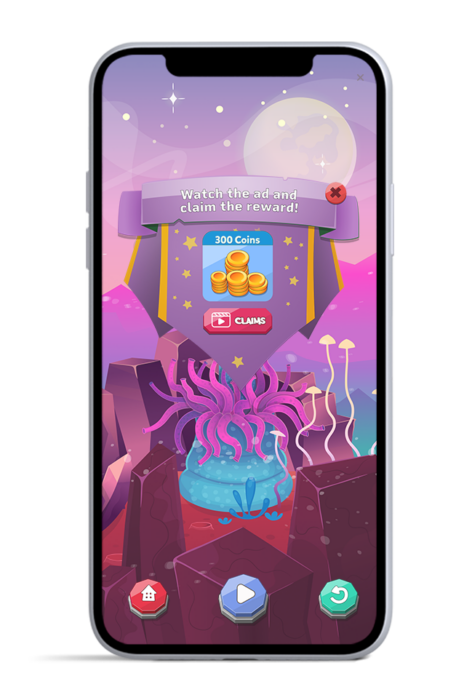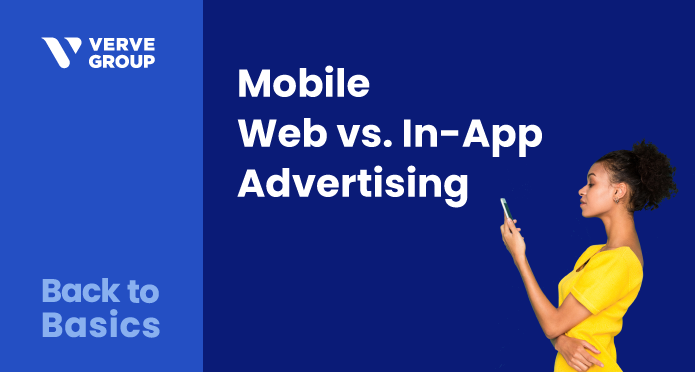If you’re in marketing, you’re very familiar with the pressure to optimize every penny in your media budget. You’re expected to be an expert on every channel in your digital marketing mix — including mobile. Brands looking to reach those of us glued to our smartphones (a.k.a. all of us) can choose between mobile web and mobile in-app advertising, two often-misunderstood marketing channels. By the end of this post, you’ll be able to impress anyone in ad tech with spot-on definitions of mobile web and in-app advertising, pros and cons of each, trends in mobile ads for 2025, and how brands can best use these digital channels.
Editor’s note: Updated January 2025 with most recent statistics available.
Defining Mobile web vs. mobile in-app advertising
Snapshot: Mobile web advertising
- What it is: Ads displayed on websites viewed in a mobile browser.
- Common ad formats: Display, banner, pop-up, native, video, and more.
- Common campaign objectives: Awareness, traffic, and lead generation.
- Top KPIs: CPMs, reach, CTR.
Mobile web refers to the browser-based experience where users access websites using an app like Chrome or Safari. Just like on desktop PCs or laptops, mobile web ads can appear as banners, videos, or pop-ups on the mobile device’s browser. Unlike desktop web browsers, mobile web can offer additional mobile-specific features, like click-to-call, tap-to-map, and deep-linking functionality.
The mobile web is literally the entire internet on the go, so the diversity of content is unlimited. This allows advertisers to reach audiences based on their interests across the internet rather than in a specific app. This vast selection of ad inventory also means that mobile web offers a huge advantage for contextual targeting and opportunities to scale.
Snapshot: In-app advertising
- What it is: Ads displayed within a mobile app.
- Common ad formats: Rich media, interstitials, playable, rewarded video, etc.
- Common campaign objectives: Conversions, user acquisition, app installs, traffic.
- Top KPIs: ROAS, CPA/CPL, CTR.
In-app advertising is the practice of displaying ads within specific apps on a mobile device. Consumers are using mobile apps more than ever; as of June 2024 smartphone users spent nearly four hours per day in mobile apps, a 3% increase from 2023.
Brands and advertisers have plenty of options for in-app advertising. Innovative ad formats like interstitial, rewarded, and playable ads can blend seamlessly into an app’s design, delivering a more natural and engaging user experience.
But that’s not all — in-app ad inventory is also considerably safer than mobile web ads when it comes to inventory quality and ad fraud. For example, made-for-advertising sites account for nearly 10% of total ad spend on web. However, they are only 0.1% of in-app ad spending. For advertisers, this means that the in-app environment is much more brand safe and can lead to more effective campaigns.
Understanding the user’s mobile ad experience
One of the biggest mistakes you can make in programmatic advertising is to ignore or deprioritize the user experience on each channel. What does this mean when comparing mobile web and in-app?
Mobile users viewing content in apps like Chrome or Safari are more likely to be in a browsing mindset. (They are using a browser, after all.) Mobile web ads must capture the user’s attention quickly — without getting in the way. Many key ad formats do this really well. For example, native ads seamlessly blend into the surrounding content, delivering a positive, unobtrusive user experience that can improve engagement and boost brand sentiment. Video ads also tend to work well on mobile web. These formats can help combat “banner blindness” to help advertisers boost engagement.
In-app users are more deeply engaged with the content they’re viewing. Because the mobile user is immersed in a full-screen app, ads don’t have to compete with the distractions of a browser with a million open tabs and notifications crowding the screen. In-app ads can provide a rich, visually stimulating experience — but at the risk of slow loading times, depending on how powerful the mobile device’s processing capabilities are.
Ad experience also matters with in-app ads, as intrusive ads can ruin the UX, negatively impacting brand perception and driving users away from the app. On the bright side, a positive UX with an engaging ad format (think rewarded video or playable interstitials) can boost brand sentiment and keep the user coming back for more.

Pros and cons of mobile web vs. mobile in-app ads
Mobile web ads and in-app ads each have unique advantages and disadvantages. Both can be effective, and many advertisers use a combination of mobile web and mobile in-app as part of an omnichannel marketing mix. Still, you’ll need to weigh the pros and cons of each when building a digital marketing strategy.
Benefits: Mobile web ads
- Tends to be budget-friendly, with a relatively low barrier to entry.
- Some formats offer seamless UX.
- Can reach broad audiences across various platforms.
- Good for awareness campaigns.
- Scalable and compatible with contextual targeting.
Challenges: Mobile web ads
- Can be less effective due to less precise targeting.
- Some formats aren’t great for UX; can be considered annoying.
- Users can easily ignore mobile web ads, a.k.a. “banner blindness.”
- More impacted by ad blockers.
Benefits: In-app ads
- Highly targeted, meaning less ad waste and lower CPMs.
- Innovative, immersive ad formats drive better engagement.
- Less intrusive, resulting in higher conversions.
- Potentially smoother ad experience for users.
Challenges: In-app ads
- Often more expensive to produce.
- Risk of slower load time, depending on a device’s processing power.
- Potentially inconsistent ad experience on different devices due to lack of standardized in-app platforms.
At the end of the day, choosing the right type of programmatic advertising for mobile depends on your marketing objectives, target audience, and budget.
Which mobile ad channel is better?
Choosing the right programmatic advertising channels and mobile ad formats shapes how you reach your target audience and drive conversions. That’s why understanding the differences between mobile web and in-app advertising is crucial for media buyers, advertisers, and brands to make informed decisions and maximize their ad spend. But, like so many questions in marketing, the answer to “Is mobile web or in-app better for my business?” is a hearty “It depends!”
Fortunately, marketers and advertisers don’t face an all-or-nothing choice when weighing mobile web vs. in-app programmatic advertising. A savvy advertising strategy will rely on a mix of both in-app and mobile web ads. Mobile web and mobile app ads can even work together. With deep-linking, a mobile web ad can drive users to the App Store or Google Play to download an app, while contextual deep links can bring users directly to a page in-app.
Want to learn more about how Verve can help you deliver outstanding user experiences on mobile devices? We’d love to hear from you.
FAQs: Mobile web and in-app advertising trends in 2025
Which is more popular: mobile web or in-app ads?
In-app advertising drives the consistent growth of mobile ad spending. In 2020, in-app accounted for 79.8% of total mobile ad spending according to eMarketer. In 2025, in-app ad spending is on track to reach 126% growth in five years, now accounting for 82.3% of mobile ad spending.
What are the best in-app ad formats?
In-app advertising offers many engaging ad formats that can help advertisers make a big impression (no pun intended). Native ads are available in-app too, but other popular formats can further improve engagement.
For example, rewarded video ads are an incredibly engaging and popular in-app format. Users opt in to watch an ad to receive in-app rewards. For example, with gaming apps, rewarded videos can help players reach a hidden level, gain an extra life, or earn coins. Marketers only have to pay when a user watches an ad to completion, making rewarded video ads cost-effective and impactful. And, because users choose to engage with ad content in exchange for a reward, they tend to prefer this ad format, and rewarded ads can even improve brand perception.
Splash ads are full-screen interstitials that appear when a user first loads an app. Because it’s the first thing users see while paying complete attention to the app, splash ads tend to have high engagement rates and don’t interrupt the user’s app experience, making them a highly favorable format.
Are all mobile ad formats compatible with every mobile device?
Depending on a smartphone’s capabilities, some ad formats perform better than others. That said, more power = more impressive ad creative. Processing capabilities on mobile devices are constantly improving, making it easier to load more complex ads. Partnering with an mobile ad exchange with a powerful ad rendering engine is vital for both campaign efficiency and positive user experience. Additionally, the rollout of 5G mobile networks paved the way for delivering flashier ads, and you can expect to see further innovations in ad formats in the future.









